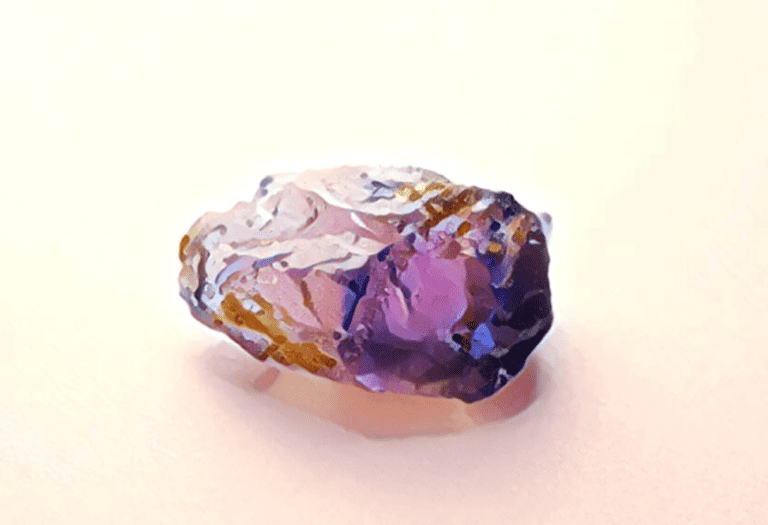Discovering the serene beauty of amazonite is like uncovering a hidden gem in nature’s vast treasure chest.
You’ve probably seen its captivating turquoise-green color, but do you know how to identify a genuine piece? Whether you’re a seasoned collector or a curious newbie, distinguishing real amazonite from imposters is crucial.
In this guide, you’ll learn the key characteristics that set amazonite apart. From its unique color variations to the subtle patterns that dance across its surface, you’ll be equipped to spot authentic amazonite like a pro.
Dive in and let’s demystify the secrets of this alluring gemstone together.
To identify genuine amazonite, look for its turquoise-green color and vitreous luster. It’s non-magnetic, ranks 6-6.5 on Mohs scale, and has a white streak. Amazonite shows translucency, single refraction, and a specific gravity of 2.56-2.58. Found in granitic rocks, it’s distinguished by its color variations and patterns.
How to Identify amazonite Through Testing
Visual Inspection
Careful scrutiny is your first line of defense. You’ll want to observe amazonite’s signature hue—an alluring turquoise-green. However, be on the lookout for uniformity in color; natural stones typically exhibit slight variations. Inspect for a glassy luster as well, as genuine amazonite presents a vitreous sheen.
The Streak Test
The streak test is a telltale method to verify authenticity. To perform, you’ll drag your amazonite across unglazed porcelain and observe the streak color. Amazonite should leave a white streak, differentiating it from potential look-alikes that leave colored streaks.
Magnet Test
Surprisingly simple, the magnet test involves passing a magnet over the stone. True amazonite is not magnetic; if your specimen pulls towards the magnet, you’re likely dealing with an imposter.
Hardness Test
Amazonite scores a 6 to 6.5 on the Mohs hardness scale. You can test this by trying to scratch your sample with a steel blade. If it’s genuine, the blade should not leave a mark, indicating proper hardness.
Birefringence Test
Examine the amazonite under a polariscope. If the stone displays light and dark patterns when rotated, that’s a sign of birefringence and confirms the stone’s authenticity.
Checking The Diaphaneity
Look at how light passes through your stone. Amazonite should be translucent to opaque. If light doesn’t penetrate at all, consider reconsidering the sample’s authenticity.
Single or Double Refraction
Utilize a refractometer to distinguish amazonite’s refraction type. Authentic stones exhibit double refraction due to their crystalline structure, appearing as two distinct shadow lines within the tool.
Refractive Index Test
The refractive index of amazonite falls between 1.522 and 1.530. This test is conducted with specialized equipment and can definitively confirm if you’re handling genuine amazonite.
Finding The Specific Gravity
Determine the specific gravity of your stone by weighing it in air and then suspended in water. Real amazonite has a specific gravity range of 2.56 to 2.58.
| Environment | Weight | Specific Gravity |
|---|---|---|
| Air | W1 | |
| Water | W2 | W1/W2 |
Identifying Amazonites in the Field
When searching for amazonite in nature, check typically granitic and metamorphic rocks. They’re often found in association with quartz and feldspar, hinting at the presence of amazonite.
Recognizing Potential Amazonite Rocks
In their rough state, potential amazonite rocks have a distinctive greenish color on the surface. They may display a matte finish and often occur alongside lighter colored minerals, which can help in distinguishing them from the surrounding stones.
Physical Characteristics of amazonites

Amazonite, a feldspar mineral, is renowned for its captivating turquoise to greenish-blue hues, a quality that can instantly grab your attention and differentiate it from other minerals. Typically, the color ranges from light green to blue-green, and sometimes, it exhibits fine white streaks or has a mottled appearance. These distinctive color patterns stem from the presence of lead and water in its crystal structure.
In terms of luster, amazonite has a vitreous to pearly sheen which can enhance the visual appeal of the stone. When held up to the light, it displays a glassy brightness that’s quite characteristic of this mineral.
Cleavage in amazonite is perfect in one direction and good in another, creating facets that reflect light and amplify the stone’s intrinsic beauty. This property can be particularly useful to gem cutters and enthusiasts looking for quality specimens to craft into jewelry or decorative pieces.
With a Mohs hardness scale rating of 6 to 6.5, amazonite exhibits decent durability, capable of withstanding scratches from metal blades. However, due to its perfect cleavage, the stone must be handled with care to prevent chipping or cracking.
Amazonite’s crystal system is typically prismatic, with elongated and flattened crystals. These forms can help you recognize raw samples, especially when present in clusters within their natural rock matrix. Considering amazonite’s density, it feels heavier than common rock-forming minerals of a similar size, which can also be a telling sign of its identity.
Spotting amazonite in the rough can be a thrilling experience, with its distinct features hinting at the treasures you might uncover. Keep an eye out for these traits and you’ll likely pinpoint the serene allure of amazonite amidst other minerals.
How Are amazonite Formed?
Amazonite, a stunning variety of microcline feldspar, forms through a fascinating geological process that might pique your interest. It all starts deep within the Earth’s crust, where the right conditions of pressure and temperature allow potassium, oxygen, silicon, and aluminum to bond and create the minerals that ultimately crystallize into amazonite.
Typically, these minerals are found in igneous rocks, such as granite. They solidify from molten magma under the Earth’s surface. As magma cools slowly, crystals have time to form and grow, which is why amazonite is often found in larger and well-shaped crystals.
In some cases, you’ll find amazonite in pegmatites. These are exceptionally coarse-grained igneous rocks that undergo the same cooling process but on a much larger scale. The expansive growth environment in pegmatites allows amazonite crystals to reach impressive sizes and exhibit their characteristic green to blue-green hues.
Interestingly, amazonite can also develop in metamorphic rocks. This transformation happens when existing minerals are subjected to new pressures and temperatures but don’t melt. Instead, they undergo a solid-state recrystallization, which means the original rock takes on a new mineral composition and texture.
Here’s a brief overview of where you might unearth amazonite:
- Igneous rocks, such as granite and pegmatites
- Metamorphic rocks through the process of recrystallization
Environmental factors play a role in the final appearance of amazonite, with specific impurities affecting its color and clarity. As part of your amazonite-identification journey, understanding these formations can offer insight into the mineral’s various characteristics.
Preparation for amazonite Hunting
Before you venture out into the field to hunt for amazonite, ensure you’re fully equipped for the task at hand. Being well-prepared increases your chances of success and makes the experience much more enjoyable and safe.
Gathering the Right Tools
Essential equipment can make or break your amazonite hunting. You’ll want to pack:
- A sturdy geologist’s hammer or rock pick, vital for extracting specimens.
- Chisels in various sizes, which come in handy for prying apart rocks.
- Safety goggles to protect your eyes from flying debris.
- A strong backpack to transport your finds and tools.
- Durable gloves to protect your hands while handling rough material.
- A topographic map of your hunting area or a reliable GPS device to navigate terrain and locate potential amazonite deposits.
With the right tools at your disposal, you’re more likely to identify and retrieve quality specimens effectively. Remember, your equipment should suit the terrain you’re exploring and the size of amazonite you anticipate finding.
Safety Considerations
When hunting for minerals like amazonite, your safety should always be the priority. Abide by safety practices to minimize risks:
- Inform someone of your planned route and estimated return time.
- Dress in layers and wear appropriate footwear for tough ground conditions.
- Bring plenty of water to stay hydrated, along with some high-energy snacks.
- Carry a first aid kit to handle minor injuries.
- Keep a fully-charged cell phone and perhaps a portable charger with you in case of emergencies.
- Be aware of local wildlife and the potential hazards they might pose.
- Understand the legal aspects of land access, and always obtain necessary permissions to avoid trespassing.
Providing for your safety and preparedness will help maintain focus on enjoying the challenge of amazonite hunting, allowing you to spend your time and effort on the thrilling search for this beautiful stone.
Handling and Care of Found amazonites

Once you’ve successfully hunted down amazonite, taking proper care of your finds will help preserve their natural beauty and value. Amazonite can be a durable gemstone, with a Mohs scale hardness of 6-6.5, but it still requires careful handling to maintain its luster and avoid scratches.
Cleaning Amazonites
First and foremost, rid your amazonite of dirt and debris by using a gentle approach to cleaning. You’ll want to avoid any harsh chemicals or ultrasonic cleaners as these can damage the stone. Instead, opt for warm soapy water and a soft brush such as a toothbrush to gently scrub the surfaces. Here’s a simple cleaning procedure:
- Fill a bowl with warm water and a mild dish soap.
- Place your amazonite stones in the soapy water.
- Let them soak for several minutes.
- Using a soft-bristled toothbrush, gently scrub the stones to remove dirt.
- Rinse the stones under running water to wash away any soap residue.
- Dry the stones with a soft, lint-free cloth.
Avoid drastic temperature changes during the cleaning process as they could cause cracks in the gemstone. Also, remember to plug the sink if you’re rinsing your amazonite under running water to prevent any accidental losses.
Storing Amazonites
Proper storage is critical to keep your amazonites safe when they’re not being displayed or used. To prevent scratches, store each piece separately. Soft pouches made of fabric like velvet can protect individual stones. You could also use a dedicated jewelry box with divided compartments to keep your specimens separate. Consider these tips for optimal storage:
- Wrap each amazonite in a soft cloth or place it in a fabric pouch.
- Ensure individual boxes or compartments are padded.
- Keep your amazonite away from direct sunlight as prolonged exposure may fade its color.
- Maintain a stable temperature and humidity level where you store your amazonite to prevent any potential damage due to environmental conditions.
Regular attention to these storage principles will go a long way in maintaining the integrity and beauty of your collection. Remember to handle your amazonite with care whenever you’re moving them or showing them to others, as even accidental knocks can cause chips or fractures.
Conclusion: Confirming Amazonite Real
You’ve got the knowledge to identify amazonite and understand how to care for your gemstone.
Remember that gentle cleaning with warm soapy water and a soft brush will keep your amazonite in top condition. Store it properly to protect its luster and avoid potential damage. With these tips, you’ll ensure that your amazonite remains a stunning piece in your collection.
Cherish your find and enjoy the vibrant hues and tranquil vibes that this unique stone brings to your life.




![Virginia Rockhounding Sites in [year]: Guide & Finds](https://observationhobbies.com/wp-content/uploads/2024/01/GLmeOzdUxOYuYKnhLJv6g-768x439.jpg)


